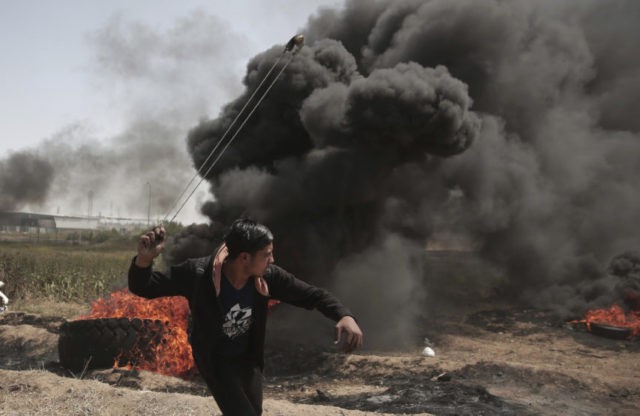KHUZAA, Gaza Strip (AP) — Palestinians torched piles of tires near Gaza’s border with Israel on Friday, sending huge plumes of black smoke into the air and drawing Israeli fire that killed one man in the second large protest in the volatile area in a week.
At least 40 protesters were hurt, including five seriously, the Gaza Health Ministry said, but did not provide a breakdown of the types of injuries. Friday’s death brought to 23 the number of Palestinians killed in Gaza over the past week, including 17 protesters.
Friday’s march was the second in what Gaza’s Hamas rulers said would be several weeks of protests against a decade-old border blockade of the territory. Israel has accused the Islamic militant group of using the protests as a cover for attacking Israel’s border, and has warned that those approaching the fence put their lives at risk.
On Friday, thousands of Palestinians streamed to five tent encampments that organizers had set up at various points from north to south, each about several hundred meters from the border fence.
In one camp near the border community of Khuzaa, activists moved closer to the fence and torched large piles of tires, engulfing the area in black smoke meant to shield them from Israeli snipers.
Israeli troops on the other side of the fence responded with live fire, tear gas and rubber-coated steel pellets. Water cannons trained a stream of thick liquid at the fence.
Within minutes, several young men with gunshot wounded began arriving at a field clinic at the camp.
Mohammed Ashour, 20, who had been among the first to set tires on fire, had been shot in the right arm. He rested on a stretcher placed on the ground.
“We came here because we want dignity,” he said before paramedics carried him to an ambulance to be transported to the strip’s main hospital.
Yehia Abu Daqqa, a 20-year-old student, said he had come to demonstrate and honor those killed in previous protests.
“Yes, there is fear,” he said of the risks of advancing toward the fence. “We are here to tell the occupation that we are not weak.”
An Israeli military spokesman, Lt. Col. Jonathan Conricus, portrayed the protests as riots, and said Hamas organizers are trying to use them as a diversion to “open up the fence and then to insert terrorists into Israel.
Israel has drawn sharp criticism for its open-fire orders along the border, including the warnings that those approaching or trying to damage the fence would be targeted.
The U.N. human rights office said Friday that it has indications that Israeli forces used “excessive force” against protesters last week.
Rights groups have branded orders permitting the use of lethal force against unarmed protesters as unlawful. A leading Israeli rights group, B’Tselem, issued a rare appeal to Israeli soldiers this week to refuse “grossly illegal” open-fire orders.
Conricus said snipers are used “sparingly” and only against those that pose a “significant threat.”
A White House envoy urged Palestinians to stay away from the fence. Jason Greenblatt said the United States condemns “leaders and protesters who call for violence or who send protesters — including children — to the fence, knowing that they may be injured or killed.”
In all, 23 Palestinians were killed in Gaza over the past week, including 17 protesters, according to Gaza health officials.
The six other deaths included three gunmen killed in what Israel said were attempts to attack the border and three men who were struck by Israeli tank fire.
Last week’s turnout was apparently driven by the organizational prowess of Hamas as well as the growing desperation of Gaza residents who live in what has been described as the world’s largest open-air prison.
The crowd size was seen as a test for Hamas, an Islamic militant group that seized the territory in 2007 from its political rival, Palestinian President Mahmoud Abbas.
Ahead of Friday’s march, Hamas announced it would pay compensation to families of those killed or injured, ranging from $200 to $500 per injury and $3,000 per death.
The idea of mass protests was initially floated by social media activists, but was later co-opted by Hamas, with the backing of smaller militant factions.
For Hamas, it’s perhaps the last chance to break a border blockade enforced by Israel and Egypt since 2007, without having to succumb to demands that it disarm.
The blockade has made it increasingly difficult for Hamas to govern. It has also devastated Gaza’s economy, made it virtually impossible for people to enter and exit the territory and left residents with just a few hours of electricity a day.
Hamas leaders billed the final protest, set for May 15, as the “Great March of Return” of Palestinian refugees and their descendants, implying they would try to enter Israel. But they stopped short of specifically threatening a mass breach of the border fence.
Israel has warned that it will not permit a breach of the fence and said it has a right to defend its sovereign border.
Military officials have said Hamas has used the protests as a cover for damaging the fence, planting explosives and, in one incident, opening fire on soldiers.
Israel argues that Hamas could have ended the suffering of Gaza’s 2 million people by disarming and renouncing violence.
Hamas has refused to give up its weapons — even at the cost of derailing talks on getting Abbas to assume the burden of governing Gaza, seen by Israel and Egypt as a prerequisite for opening Gaza’s borders.
___
Associated Press writers Karin Laub and Mohammed Daraghmeh in Ramallah, West Bank, Ian Deitch in Jerusalem, and Josef Federman on the Gaza border contributed to this report.

COMMENTS
Please let us know if you're having issues with commenting.